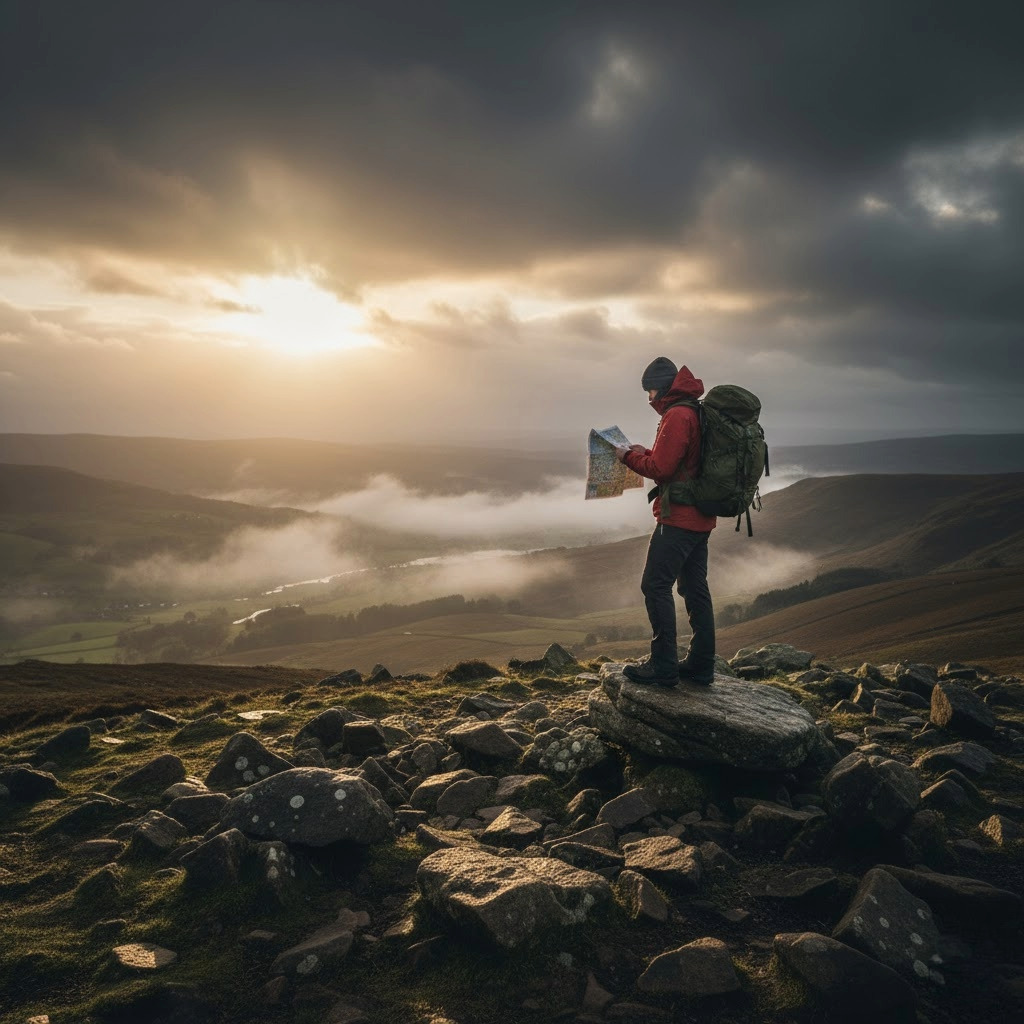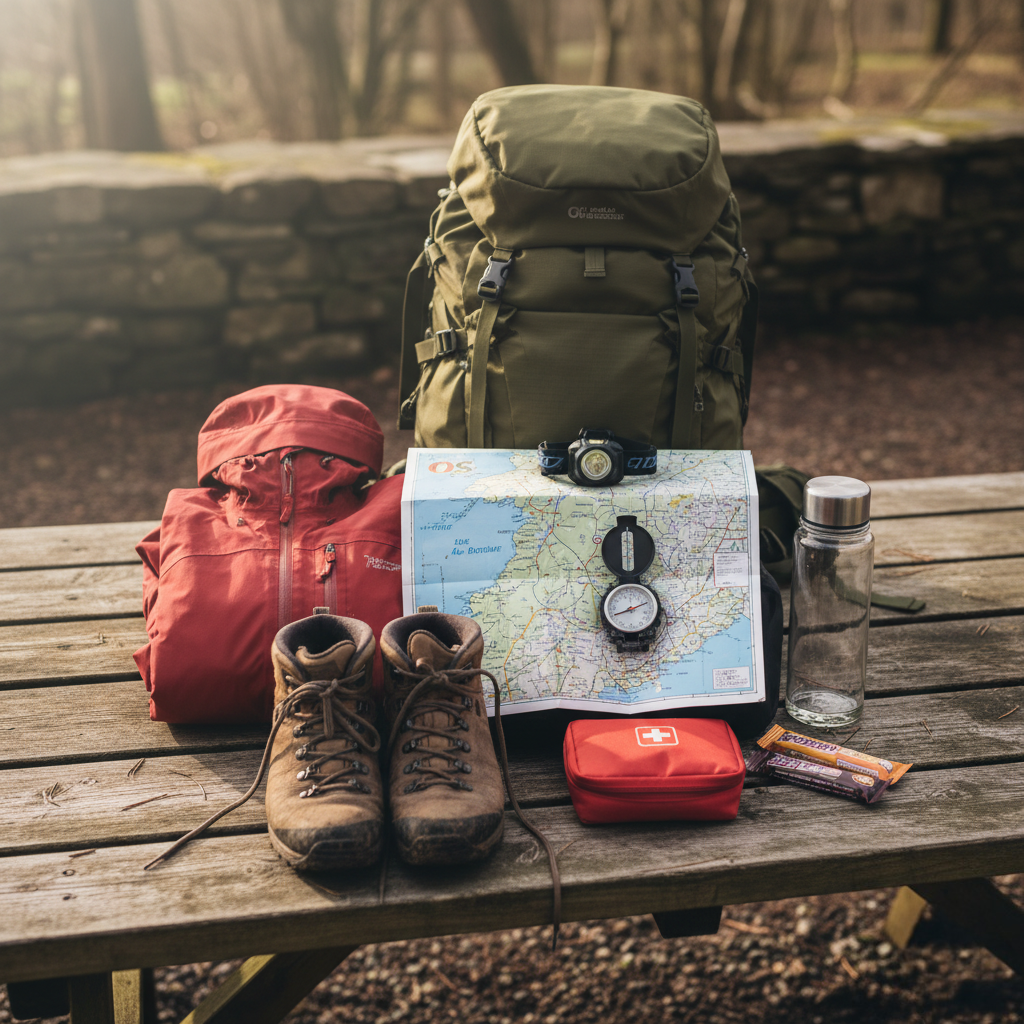Whether you’re tackling the Lake District fells, exploring the Scottish Highlands, or rambling through the Peak District, being properly prepared can make the difference between an enjoyable day out and a potential emergency. British weather is famously unpredictable, and even seemingly gentle hills can present serious challenges when conditions change.
The concept of the “10 Essentials” originated with mountaineers but has evolved into a system that every hiker should follow. Here’s my guide to the must-have items for UK hiking, adapted for British conditions and terrain.
1. Navigation Tools
What you need: A detailed OS map (1:25,000 scale), compass, and ideally a GPS device or smartphone with downloaded offline maps.
Even on well-marked trails, conditions can change rapidly. Mist can descend without warning, particularly in upland areas, reducing visibility to just a few metres. A paper map and compass don’t rely on batteries and should be your primary navigation tools. Apps like Hiiker or OS Maps are excellent backups, but always download maps for offline use before you set out. Mobile signal can be patchy or non-existent in many UK hiking areas.
Top tip: Know how to use your compass before you need it. A compass is useless if you can’t take a bearing.
2. Sun Protection
What you need: Sunscreen (minimum SPF 30), sunglasses, and a sun hat.
Yes, even in Britain! UV rays can be surprisingly strong, especially at altitude and when reflected off water or snow. Scottish winters and spring walks on snowfields require particular care. Sunburn and snow blindness are real risks, even on overcast days. The British weather might not give you a tan, but it can certainly give you sunburn.
3. Insulation Layers
What you need: Multiple layers including a base layer, mid-layer fleece, and insulated jacket.
The British climate demands versatile layering. Temperature can drop significantly with altitude—roughly 2°C per 300 metres—and wind chill can make it feel far colder. Pack a warm mid-layer even on summer days, and always carry a down or synthetic insulated jacket for stops or emergencies. Remember: cotton kills. Choose wool or synthetic fabrics that retain warmth when wet.
The layer system:
- Base layer: Moisture-wicking merino wool or synthetic
- Mid-layer: Fleece or lightweight insulated jacket
- Outer layer: Waterproof jacket (see next item)
- Spare warm layer: Down or synthetic jacket for emergencies
4. Waterproof Protection
What you need: A proper waterproof jacket and trousers with taped seams.
In the UK, this might be the most essential item of all. British weather can deliver horizontal rain driven by strong winds, and getting soaked can quickly lead to hypothermia, even in summer. Don’t rely on a lightweight rain jacket—invest in proper waterproofs with a minimum 10,000mm hydrostatic head rating. Waterproof trousers often get overlooked but are crucial for comfort and safety in sustained rain.
5. Illumination
What you need: A head torch with spare batteries, or a rechargeable torch with power bank.
Days are short in British winters—sunset can be as early as 3:45pm in December. Even if you plan to finish before dark, delays happen. A twisted ankle, taking a wrong turn, or simply walking slower than expected can leave you needing light. A head torch keeps your hands free for using poles or scrambling. Always carry spare batteries or a charged power bank.

6. First Aid Kit
What you need: A comprehensive kit including blister treatments, bandages, pain relief, and any personal medications.
At minimum, your kit should include:
- Plasters in various sizes
- Blister prevention and treatment (Compeed or similar)
- Bandages and sterile dressings
- Antiseptic wipes
- Paracetamol or ibuprofen
- Tick removal tool (essential for UK hiking)
- Any personal medications including antihistamines
- Emergency foil blanket
- Medical tape and scissors
Don’t forget: A whistle for emergencies (the international distress signal is six blasts repeated at one-minute intervals).
7. Fire Starting Equipment
What you need: Waterproof matches or a lighter, sealed in a waterproof bag.
While you’re unlikely to need to start a fire for warmth on most UK hikes, having the means to do so provides an important safety margin in emergencies. This is more relevant for remote Scottish Highland walks or multi-day expeditions. Always check if you’re in an area where lighting fires is permitted—many UK national parks have restrictions, especially during dry periods.
8. Repair Kit and Tools
What you need: A multi-tool, duct tape, safety pins, and equipment-specific repair items.
British terrain can be tough on gear. Rocky scrambles, barbed wire fences, and dense vegetation can damage clothing and equipment. A small repair kit can keep you going:
- Multi-tool with knife, scissors, and pliers
- Duct tape (wrap some around a pencil to save space)
- Safety pins
- Cable ties
- Spare bootlaces
- Rucksack buckle spares
9. Nutrition and Hydration
What you need: More food and water than you think you’ll need.
Plan for at least one litre of water per person for a four-hour hike, more in hot weather or on strenuous routes. While the UK has many streams, not all water sources are safe to drink without treatment. Carry water purification tablets as backup.
Pack high-energy foods that won’t freeze or melt:
- Sandwiches or wraps
- Trail mix, nuts, and dried fruit
- Energy bars
- Chocolate (though it melts easily in summer)
- Hot drink in a flask (brilliant for British weather)
Emergency rations: Always pack extra food you don’t plan to eat. High-calorie items like flapjacks or energy gels could be vital if you’re delayed or injured.
10. Emergency Shelter
What you need: An emergency bivi bag or group shelter.
British weather can deteriorate rapidly, and if someone in your group is injured or suffering from hypothermia, getting out of the wind and rain is critical. An emergency bivi bag (also called a survival bag) weighs almost nothing and could save your life. For groups, a lightweight group shelter provides protection for multiple people while waiting for help.
Bonus item: A fully charged mobile phone in a waterproof case or bag. Even without signal, you can often get through to emergency services (999 or 112).
Adapting for Your Hike
The 10 essentials provide a framework, but you should adapt your kit based on:
Season: Winter hiking requires more insulation, possibly microspikes or crampons, and an ice axe for mountain routes.
Duration: Day walks versus multi-day trips need different approaches to food, water, and clothing.
Location: Remote Scottish Highlands require more comprehensive emergency equipment than a gentle Cotswolds walk.
Group: Walking with children, less experienced hikers, or those with medical conditions may require additional items.
Weather forecast: Check the mountain weather forecast (MWIS for Scotland and the Lake District) and pack accordingly.
The Weight Question
Some hikers worry about carrying all this gear, especially in summer. Remember: the best safety equipment is the gear you have with you when you need it. A well-organized rucksack with these items typically weighs 3-5kg—a small price for safety and peace of mind.
Pack smart by using stuff sacks to organise items, and keep frequently needed items like snacks, map, and sun cream accessible. Heavier items should sit close to your back at roughly shoulder blade height.
Know Before You Go
Finally, always tell someone where you’re going and when you expect to return. Leave a route card or send a text with your plans. The British hills are beautiful but can be unforgiving when things go wrong.
Remember: The best outdoor adventure is one where everyone returns home safely with fantastic memories. These 10 essentials give you the foundation for safe, enjoyable hiking throughout the UK, whatever the weather throws at you.
Happy hiking, and stay safe on the trails!

Leave a Reply